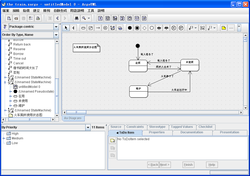| ArgoUML | |
|---|---|
 | |
| Initial release | April 1999 |
| Stable release | |
| Repository | |
| Written in | Java |
| Platform | Java SE |
| Type | Software development, UML Tool |
| License | Eclipse Public License 1.0 |
| Website | argouml |
ArgoUML is an UML diagramming application written in Java and released under the open source Eclipse Public License. By virtue of being a Java application, it is available on any platform supported by Java SE.